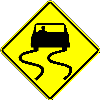Global Navigation

Main Navigation
Sub-Navigation

Content
Understanding what traction is and how it is used is the first step towards managing our traction. The challenge is that our available traction comes from the friction between those two little areas of contact where our tires actually meet the road. All of these traction users must vie for their traction needs from the same pool of available traction, namely that generated by those two little contact patches. And any of these three traction users can acquire an appetite that eats up all of our available traction. This is especially true when we are riding under less than desirable conditions like when riding on a wet road surface.
Road racers ride on the edge using all the traction they have to get around the track as quickly as they can. On the street, we need to hold some traction in reserve for those unexpected situations that seem to crop up. Managing our traction will help ensure our trip remains enjoyable. So how do we manage our traction so we don't try to overuse it? What can we do to ensure we have as much traction as we possibly can?
Obviously the first thing we can do is to make sure we get maximum friction between our tires and the road surface. Having the proper tires for the type of riding we do is a good starting point. Not all tires are the same. The rubber compound used to make the tires varies. Softer compounds provide more traction than harder compounds because they grip the road better. That's why performance bikes often have a softer tire on them than touring bikes.
Sidebar
Footer
Copyright 1996-2015 Chuck Miles All Rights Reserved
All information on this site, including all articles, are copyrighted materials belonging to Chuck Miles.
Design: Made in Austria | Author: G. Wolfgang



